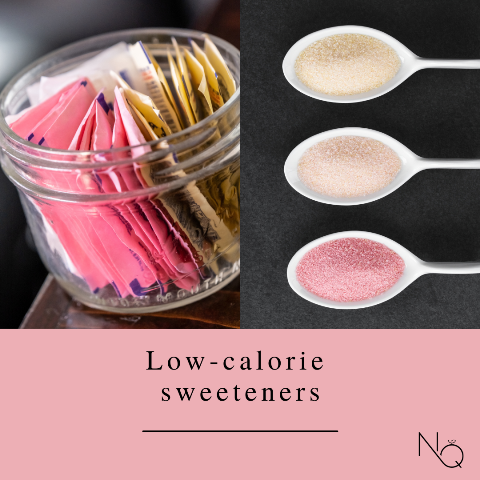What are low-calorie sweeteners?
Low-calorie sweeteners are ingredients with a sweet taste and few or no calories or substances that taste so sweet that they can be used in tiny amounts, resulting in negligible calories. That is because they can be 200 or 300 times sweeter than sugar (like stevia). Many products include low-calorie sweeteners, such as food and beverages, chewing gum, ice creams, yogurts, pastries, desserts, soft drinks, light products etc. Sometimes they are also used in the pharmaceutical industry to improve the taste of medicines. Finally, we find them in the supermarket as an alternative to sugar and honey for our drinks (see stevia, aspartame, saccharin) or sweets we prepare.
Each of the low-calorie sweeteners has a different flavor profile. That allows the industry to make combinations in type and quantity to achieve the desired sweet taste. Because of this, when choosing a low-calorie sweetener to use at home, it is good to consider that not all of them may suit us, but we should do several tests and be patient.
Difference between low-calorie sweeteners and traditional sweeteners
Oligocaloric sweeteners provide little or no calories, and the most common are acesulfame-K, stevia, aspartame, cyclamic acid, saccharin, sucralose, and steviol glycosides (stevia). Traditional sweeteners provide calories just like sugar - since they contain carbohydrates and sugars - and therefore affect the body like sugar. These are table sugar (sucrose), honey, brown sugar, molasses, fructose, maple syrup, cane sugar, agave nectar, and confectioners' sugar.
The safety of low-calorie sweeteners and E on products
The first low-calorie sweetener discovered was saccharin in 1879. Since then, we have come across many more. To check safety, we use a measure called ADI (Acceptable Daily Intake), which defines the amount of sweetener that a person can consume for a lifetime and daily without creating a problem for his body. We measure it in mg per Kg of body weight per day. Thus, a 60 kg woman could consume 280 table-top sweetener tablets or 20 cans of soft drinks with the low-calorie sweetener aspartame every day for her entire life! We understand that it is unlikely that one will reach these quantities.
All low-calorie sweeteners get listed on food packaging as additives. The letter E in additives comes from the word Europe and indicates that the additive is safe for consumption and the food industry can use it. We understand, therefore, that it is a myth that the "E" on a package indicates bad and harmful substances. On the contrary, it indicates that the respective substance has passed strict controls, and the entire EU can use it. The European Food Safety Authority (EFSA) has rejected several hypotheses supporting that sweeteners are unsafe. Thus, the ten low-calorie sweeteners that fall within the EU get listed with the following E:
• acesulfame-K (E950)
• aspartame (E951)
• aspartame salt - acesulfame (E962)
• cyclamate and its salts (E952)
• neo hesperidin DC (E959)
• saccharin and its salts (E954)
• sucralose (E955)
• thaumatin (E957)
• neotame (E961)
• steviol glycosides (E960)
Benefits of using low-calorie sweeteners
• safety
• few calories in food and drinks while maintaining the sweet taste
• do not contain sugars and do not affect insulin secretion
• contribute to the satisfaction of the sweet sensation when we need it
• help better adherence to the diet and for a prolonged period, as long as we do not feel deprived
• they help oral health due to the reduction of sugar we consume. Oral bacteria do not break down low-calorie sweeteners, so they do not produce acids that erode teeth, as with sugar.
• we can enjoy light food options that contain sweeteners versus the original version that has caloriesWho can not use sweeteners • infants up to 2 years of age, as the preparations intended for them have very exact specifications
• children, if there is no reason. Also, just because low-calorie sweeteners are safe does not mean it is healthy for children to consume commercial products instead of natural ones. Children are small in size and have high needs due to growth, so they take a grand proportion of sweeteners. However, it is hard to exceed the permissible limits.
• people with phenylketonuria (PKU), since aspartame contains phenylalanine, a substance that the body of these people cannot handle.
We diagnose PKU at birth. Also, "source of phenylalanine" is always written on the food to protect these individuals.Who can use sweeteners?
• children with type 1 diabetes to eat sweet flavors without the intake of sugars
• adults
• pregnant women
• breastfeeding women
• people with a predisposition to diabetes
• people with diabetes
• people with gestational diabetes
• people with obesity
• general population
• people with cancer or other diseasesMy scientific position
I agree with the official recommendation that we should not overdo it with any food. The same goes for low-calorie sweeteners. The fact that we can enjoy sweet-tasting food does not mean that we should rest on it, but rather explore our food choices and constantly train the taste buds of our tongues so that we can consume a variety of foods with beneficial substances for us. That is, eating and drinking products with sweeteners because they have fewer or no calories does not guarantee that we will improve our relationship with food and achieve our goals, which is always the point.
Sources
"Oligocaloric sweeteners: a safe ally in the diet of people with diabetes", Hellenic Diabetes Association, https://www.ede.gr/wp-content/uploads/2012/05/oligo.pdf




